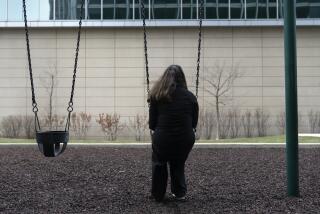Childhood Bullying Is Common, Study Finds
- Share via
Nearly one-third of U.S. schoolchildren in the sixth through the 10th grades have bullied other children or been bullied, according to the first study of its kind, published today in the Journal of the American Medical Assn.
The study, based on a poll of 15,000 schoolchildren, found that bullies and their victims are more likely to have psychological or behavioral difficulties--a finding that underscores the need for schools and society to take action, said the study’s authors.
The study was the first on this subject to survey U.S. schoolchildren from a nationally representative cross-section of ethnic groups and urban and rural populations.
“Bullying is something we need to take seriously as a nation,” said Tonja Nansel, a researcher with the National Institute of Child Health and Human Development in Bethesda, Md., and lead author of the study. “We need to not treat it as a normal part of growing up, but as a public health problem.”
The study found that bullying is more common in grades six through eight than in grades nine and 10; that boys are more often involved in bullying than girls; that boys are more more likely than girls to bully using physical force and girls more inclined to use taunts and spread rumors.
The study finds no difference, though, among rural, suburban and inner-city schools and no striking differences among ethnic groups.
Such a study is long overdue, said Dr. Howard Spivak of the New England Medical Center and Tufts University School of Medicine, who co-authored a commentary accompanying the study.
Bullying, he said, is a sign that a child is troubled. It may be linked to a pattern of later violence. Given the problems of violence in the United States, he said, “it is a sad irony that this issue has not been looked at very much in this country.”
But researchers said the study has limitations. It relies on the children’s own assessments, which may not be wholly accurate.
“The merits of the study are obvious: the size of the study and the fact that it’s a representative sample covering both middle and high school,” said Jaana Juvonen, a behavioral scientist at Rand Corp. in Santa Monica. “But it’s important to recognize that this study is all based on self-report.”
In the study, 15,686 sixth- through 10th-graders in public and private schools nationwide completed an anonymous questionnaire in class. It included 102 questions about a range of psychological health issues.
The children first read a description of bullying:
“We say a student is being bullied when another student, or a group of students, say or do nasty and unpleasant things to him or her. It is also bullying when a student is teased repeatedly in a way he or she doesn’t like. But it is not bullying when two students of about the same strength quarrel or fight.”
Overall, 29.9% of the children reported that they had been involved in bullying “sometimes,” once a week or more often during that school term. Of those, 13% reported that they had bullied other children while 10.6% said that they had been bullied. And 6.3% of the children reported that they had, at different times, been bully and victim.
The researchers found that children involved in bullying were more likely to get into fights. Those who said they had been bullied also were more likely to report problems making friends, feelings of loneliness or poor relationships.
Children who were bullies and victims had it the worst. They were lonely and confessed to unsatisfactory relations with classmates. They were poor academic achievers and tended to smoke.
Fred Frankel, director of the UCLA Children’s Friendship Program, criticized the JAMA study for several reasons. For instance, he faulted the scientists’ definition of bullying.
“They’re making a common mistake, lumping together different forms of aggression,” he said. “Teasing is not bullying.”
But Nansel and Juvonen counter that teasing can definitely be bullying if it is done repeatedly and by a person in a stronger position.






